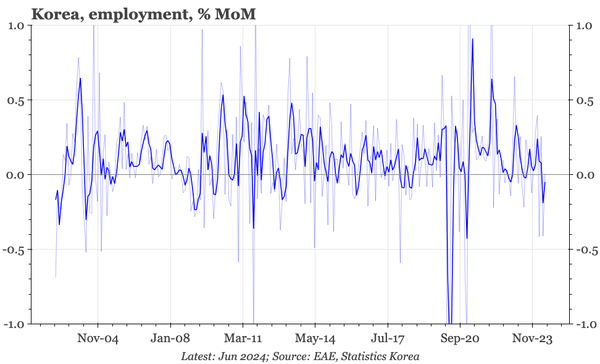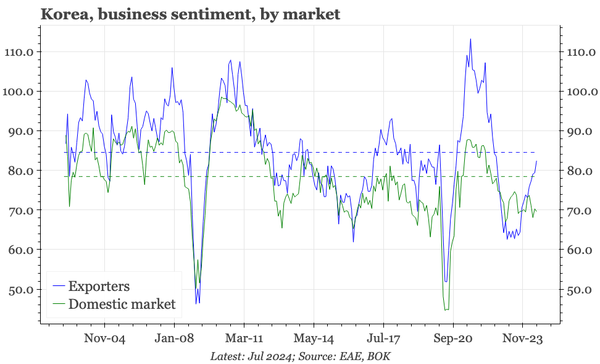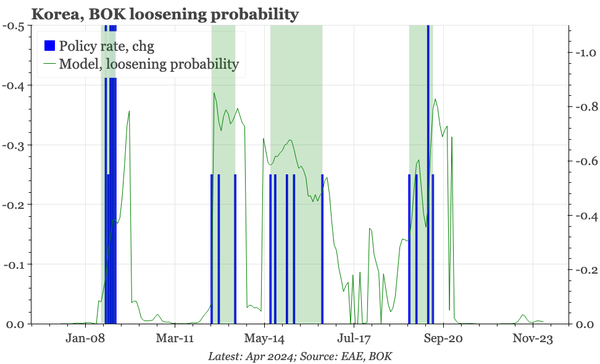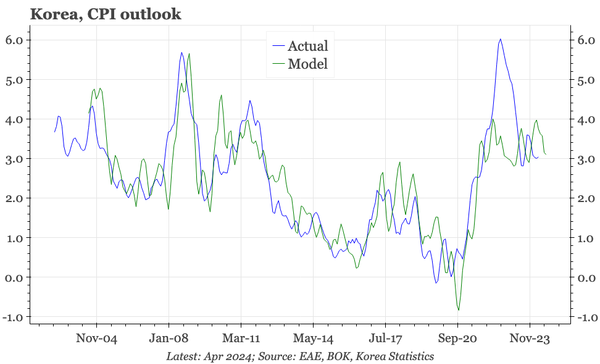Korea – no change in the labour market
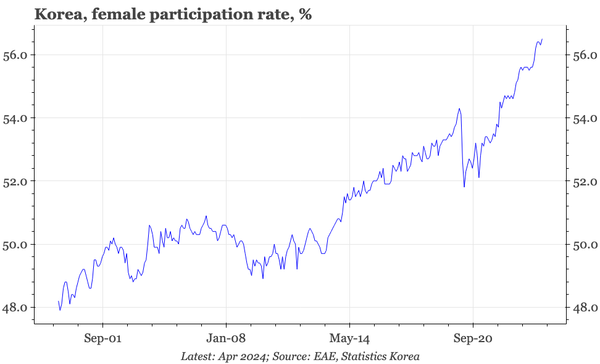
Headline developments in the labour market are consistent with the BOK's outlook for a moderation in tightness. However, the big structural changes – such as the rise in female part rate – mean these headline developments don't tell the whole story.
Korea – headline inflation still at 3%

Core inflation looks controlled, but headline continues to run around 3%. Leading indicators don't suggest that goods prices pressures are about to subside quickly. One reason is the weakness of the KRW and as a result, our model still isn't flashing the risk of a near term change in policy.
Korea – incrementally weaker

Q1 GDP was solid, but the weakness in business sentiment in April makes us feel economic momentum is incrementally weaker. The consumer survey showed price expectations remaining elevated, which fits with weekly price data showing no big slowdown in food or energy price inflation through April.
Korea – buying a bit more time

The BOK today sounded confident that core is coming down, but argued that headline is more uncertain. Of course, these two measures are different, but the distinction still feels disingenuous, and gives the impression that the bank is just trying to buy a bit more time.
Korea – activity still struggling

Business sentiment in Korea still isn't recovering. Exporter confidence has lifted, but continues to be offset by weakness among domestic firms. Price expectations in the consumer survey yesterday were probably still too high for the BOK's liking, but the probability of a BOK rate cut is growing
Korea – consumer confidence and price expectations sideways

Consumer confidence remains around the historical average, which is not strong enough to remove BOJ concern about the sluggishness of the domestic economy. However, the March survey doesn't give the bank the all-clear to act, with price expectations picking up for the second consecutive month.
Korea – talk of a "pivot"

The main takeaway from the BOK minutes for February was concern about the weakness of consumption. Inflation being above target means that policymakers don't feel able to react to that yet, but the bank is sounding more doveish, and will turn further in that direction if exports disappoint.
Korea – headline CPI up, details not

Inflation ticked up in February. That was expected by the BOK, and the details don't look particularly strong, with core stable, and trimmed mean continuing to fall. There is still an argument that inflation will be sticky, with personal services inflation remaining over 2%.
Korea – incrementally doveish again
The BOK's official stance didn't change in February. However, the tone today still became incrementally more doveish, with the governor revealing one member being open to a rate cut in the next few months.
Korea – sideways
Our view has been that the BOK would remain on hold, and that the extent to which improving manufacturing took over from services as the driver of activity in Q1 would determine the next step. That recovery in exports has been soft, which in turn increases the downside risks to rates.
Korea – supply-side shifts not big enough yet
Employment rose in January, and unemployment remains low. Recent BOK research focuses on supply-side changes that mean the labour market isn't as tight as these headline data suggest, with the participation rate high and big increases in part-time jobs. However, wage growth has also been quite firm.
Korea – the job-rich recovery
The BOK has issued another research report looking a labour market dynamics after the pandemic. The report focuses on: the rise in female and hospitality employment, which have reduced wage pressure; and labour market tightness, that is reducing labour reallocation and so dampening productivity.
Korea – CPI down, but some seasonality
January CPI inflation fell, but that was probably related to LNY, and will partly reverse in February. Beyond that, inflation will ease further. That will matter for policy if it isn't offset by stronger activity. Yesterday's PMI showed a pick-up, but other indicators haven't been so strong.

